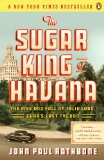Summary | Excerpt | Reviews | Beyond the Book | Read-Alikes | Genres & Themes | Author Bio

Critics' Opinion:
Readers' Opinion:
First Published:
Aug 2010, 320 pages
Paperback:
Jul 2011, 320 pages
 Book Reviewed by:
Book Reviewed by:
Elena Spagnolie
Buy This Book
This article relates to The Sugar King of Havana
In The Sugar King of Havana John Paul Rathbone describes one of the most successful and cunning business moves of Julio Lobo's career - a manipulation of FDR's Good Neighbor Policy which, according to Eduardo Kaplan of The Wall Street Journal, "placed [Lobo] in a different league."
As part of the Good Neighbor Policy, FDR enacted The Jones-Costigan Act in May of 1934. This act set up an agreement between the U.S., its sugar-producing "insular territories" (such as Hawaii and The Philippines) and overseas sugar producers - Cuba (headed by Lobo) being of particular importance here. Among other things, this agreement allowed Washington to assess the sugar needs of the US and institute a quota system in which each country would be assured a certain amount of that market. In theory this act would benefit the United States because it would protect its domestic farmers' interests and also prevent other countries, specifically Cuba, from overproducing sugar (as happened during the "Dance of the Millions"*), which drove prices down. The Jones-Costigan Act would benefit Cuba in two ways: it would assure a home for much of Cuba's sugar, and Cuba would get to sell to the US at generally higher prices.
In 1934, the other countries filled their quotas as agreed. But Cuba intentionally stalled on filling its quota because Lobo foresaw that as soon as the quotas of other producers were exhausted, Cuba would be in control of the U.S. raw sugar market until the 1935 quotas came into effect at the end of the year.
Events played out as Lobo anticipated - by late September 1934, Cuba still had several hundred thousand tons of its quota left and no competition, because the U.S. had already completed its transactions with other sugar growers. This allowed Lobo the freedom to set his own price for the remainder of Cuba's quota. Thus, in October 1934, Lobo made a two-fold agreement with U.S. sugar refiners: firstly, he would sell a large portion of Cuba's remaining quota for 2.18 cents per lb - a price that was high, but still worth it; secondly, U.S. refiners would have guaranteed access to Cuba's sugar for the rest of the year. In return, Cuba promised not to sell sugar to anyone but US refiners for the rest of the year.
This posed a major problem for U.S. sugar traders, in particular Charles Hayden and William Douglas. These traders "short sold" sugar meaning that they "borrowed" sugar from Cuba, sold it on the market with the intention of buying it back at a lower price before having to return it to Cuba, thus making a quick profit.
Initially, the bargain struck between Cuba and the refiners in the Fall of 1934 did not seem too ominous to the short traders as there was still enough other sugar available in warehouses for them to buy up at leisure. However, what they didn't anticipate was that Lobo would set Cuba's prices high, causing all sugar prices to rise. The surplus warehouses took advantage of the high prices and liquidated their stock quickly.
Cuba, of course, still had plenty of sugar, but U.S. traders weren't allowed access to it because of Cuba's agreement to only sell to U.S. refiners for the rest of the year. In November 1934, the "shorts" were caught. Quotas and agreements had closed every source of sugar - not just that year's sugar production but the vast surpluses accumulated from other years. The only thing the "shorts" could do was appeal to Washington.
As Rathbone explains, after investigations and Senate hearings Cuba was eventually "forced to sell to the Yankee shorts for 2.38 cents a pound," which still "netted an estimated profit of some $150,000" (equivalent to about $2.4 million today) for Cuba despite the fact that "in theory the Cubans could have asked whatever price they wished from the shorts." According to Rathbone, "Lobo never commented on how he cornered the New York sugar market that December. It was, he would merely say later, the only 'perfect squeeze that was ever pulled.'"
*"The Dance of the Millions" refers to a period in Cuban history shortly after the end of World War I, where the near-destruction of Europe's beet-sugar industry raised sugar prices to the point where Cuba enjoyed a massive boom. This was followed by a collapse of equivalent proportions when the world's sugar production recovered and sugar prices fell precipitously.
Filed under People, Eras & Events
![]() This "beyond the book article" relates to The Sugar King of Havana. It originally ran in September 2010 and has been updated for the
July 2011 paperback edition.
Go to magazine.
This "beyond the book article" relates to The Sugar King of Havana. It originally ran in September 2010 and has been updated for the
July 2011 paperback edition.
Go to magazine.





The House on Biscayne Bay
by Chanel Cleeton
As death stalks a gothic mansion in Miami, the lives of two women intertwine as the past and present collide.

The Flower Sisters
by Michelle Collins Anderson
From the new Fannie Flagg of the Ozarks, a richly-woven story of family, forgiveness, and reinvention.

The Funeral Cryer by Wenyan Lu
Debut novelist Wenyan Lu brings us this witty yet profound story about one woman's midlife reawakening in contemporary rural China.
Your guide toexceptional books
BookBrowse seeks out and recommends the best in contemporary fiction and nonfiction—books that not only engage and entertain but also deepen our understanding of ourselves and the world around us.